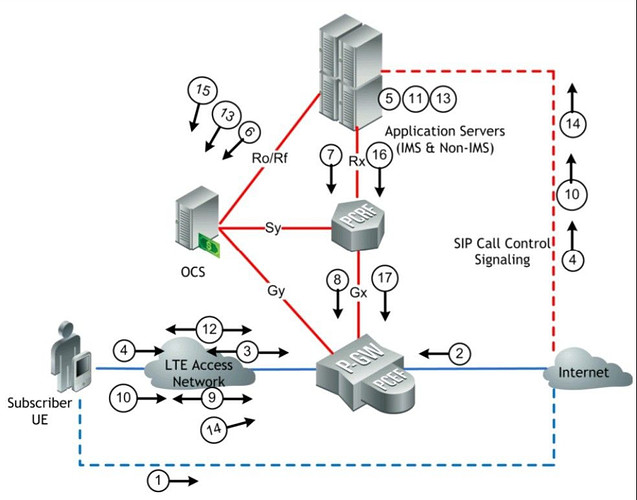- The mobile subscriber indicates on their LTE-enabled smartphone the desire to make a VoIP call.
- LTE identifies a PDN Gateway (P-GW) that offers a connection to the IMS network.
- LTE establishes a Default bearer for SIP from the subscriber to the selected P-GW.
The default EPS bearer is established with a QoS Class Identifier (QCI) value of 5 (the QCI value required for SIP signaling). - The smartphone sends a SIP “Invite” message toward the IMS network. Contained in the SIP message is a Session Description Protocol (SDP) that carries the QoS requirement.Note that although SIP messages are carried through the LTE network, the LTE network is unaware of the
content of the message (nor the need for special QoS treatment at this stage). - The IMS network extracts the required QoS setting from the SIP message.
- If a charging policy applies, then the IMS network sends an initial diameter Credit Control Request (CCR) to the OCS over the Ro interface and an initial amount of credit is reserved anticipating the need to precisely
meter flow data during the call. - The QoS requirement is sent from the IMS network through the Rx interface (using the Diameter protocol) to the PCRF.
- The PCRF creates actionable charging and QoS rules and forwards these across the Gx interface to the Policy and Charging Enforcement (PCEF) that lives with the P-GW in the LTE network.
- The P-GW now sends a request to establish a separate “dedicated bearer” (with a QCI value of 1) to the smartphone.
- After the smartphone confirms that LTE can support the new dedicated bearer, it sends a SIP “UPDATE” message to the IMS network.
- The IMS network completes the setup process and establishes the call.
- Bidirectional VoIP call packets flow inside the LTE network (to the P-GW) and smartphone.
- For charging, the IMS network requests credit from the OCS throughout the call (e.g., every 10 seconds). If credit does not exist, a 402 (payment required) message is sent back to the smartphone and the call is
cancelled. If credits expire during the call, it is terminated. - When the call terminates, the smartphone sends a SIP “BYE” message to the IMS network.
- The IMS network sends a diameter CCR termination request to the OCS, which ends the charging metering and triggers actions to collect IMS billing records.
- The IMS network notifies the PCRF of call termination.
- The PCRF tells the PCEF to close out the LTE billing, and instructs the P-GW to tear down the dedicated bearer established for the VoIP call.
3 Likes
